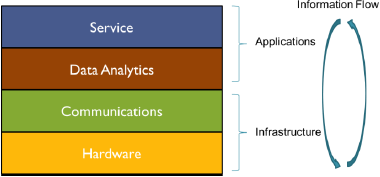Let’s try to understand IoT Architecture in a simple way. How you can implement it based on your little experience.
We can divide IoT architecture into four segments.
1. Hardware Layer which is also called Sensor Layer.
2. Network Layer which is also called Gateway Layer.
3. Data Analytics Layer
4. Application Layer.

1. Hardware Layer (Sensor Layer)
This is a starting point of IoT Architecture where we collect or produce data with different types of sensors. You can learn more about Sensors through below Url.
The main purpose of the sensing layer is to identify any phenomena in the devices’ peripheral and obtain data from Sensors.
You can say this is all electronic part of IoT architecture with programming. Programming used to collect data from Sensors and send it to Network Layer.
2. Network Layer
Network Layer is a communication channel to move data collected from Sensors to another layer. We can use various communication channels like WiFi, Bluetooth, LoRa etc. We will discuss it more in our next blog. We can also implement IoT Gateway here to filter out data. We will discuss separately IoT Gateway.
It should support scalable, flexible, standards universal protocol for transferring data from heterogeneous devices (Different types of sensor nodes). This Layer should have high performance and robust network. It should also support multiple organizations to communicate independently.
3. Data Analytics Layer
We process data received from Network Layer. We are receiving a huge amount of data in IoT. We need to handle this huge data to make it relevant for us. We take decision based on this data. In some IoT devices (e.g., smartwatch, smart home hub, etc.), the data processing layer also saves the result of the previous analysis to improve the user experience. This layer may share the result of data processing with other connected devices via the network layer.
4. Application Layer
This you can also say the presentation layer where we present data to the external world. We show this through the website or mobile devices to our users. Through this layer, we can control our devices and take remote actions. There exist diverse IoT applications, which include smart transportation, smart home, personal care, healthcare, etc.
This is a basic architecture which we can implement to achieve our IoT goal, but we need to keep in mind this cannot handle huge amount of data. So, we may need to change our architecture based on our requirement. We will discuss more in our upcoming blogs.

Thanks !!!
Keep reading and Comment!!
—


